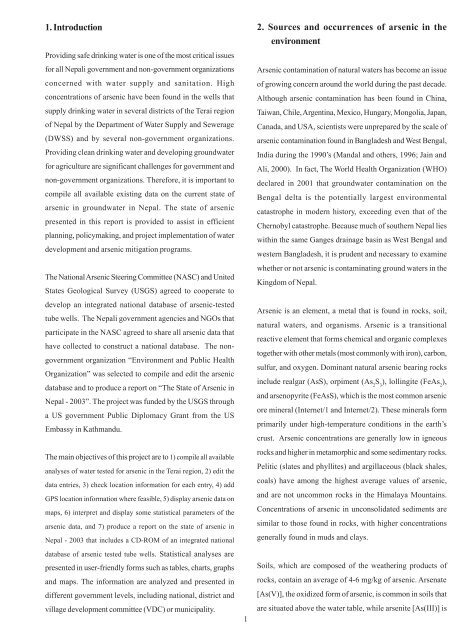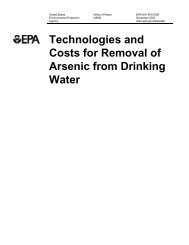The State of Arsenic in Nepal - 2003 - Harvard University ...
The State of Arsenic in Nepal - 2003 - Harvard University ...
The State of Arsenic in Nepal - 2003 - Harvard University ...
You also want an ePaper? Increase the reach of your titles
YUMPU automatically turns print PDFs into web optimized ePapers that Google loves.
1. Introduction<br />
Provid<strong>in</strong>g safe dr<strong>in</strong>k<strong>in</strong>g water is one <strong>of</strong> the most critical issues<br />
for all <strong>Nepal</strong>i government and non-government organizations<br />
concerned with water supply and sanitation. High<br />
concentrations <strong>of</strong> arsenic have been found <strong>in</strong> the wells that<br />
supply dr<strong>in</strong>k<strong>in</strong>g water <strong>in</strong> several districts <strong>of</strong> the Terai region<br />
<strong>of</strong> <strong>Nepal</strong> by the Department <strong>of</strong> Water Supply and Sewerage<br />
(DWSS) and by several non-government organizations.<br />
Provid<strong>in</strong>g clean dr<strong>in</strong>k<strong>in</strong>g water and develop<strong>in</strong>g groundwater<br />
for agriculture are significant challenges for government and<br />
non-government organizations. <strong>The</strong>refore, it is important to<br />
compile all available exist<strong>in</strong>g data on the current state <strong>of</strong><br />
arsenic <strong>in</strong> groundwater <strong>in</strong> <strong>Nepal</strong>. <strong>The</strong> state <strong>of</strong> arsenic<br />
presented <strong>in</strong> this report is provided to assist <strong>in</strong> efficient<br />
plann<strong>in</strong>g, policymak<strong>in</strong>g, and project implementation <strong>of</strong> water<br />
development and arsenic mitigation programs.<br />
<strong>The</strong> National <strong>Arsenic</strong> Steer<strong>in</strong>g Committee (NASC) and United<br />
<strong>State</strong>s Geological Survey (USGS) agreed to cooperate to<br />
develop an <strong>in</strong>tegrated national database <strong>of</strong> arsenic-tested<br />
tube wells. <strong>The</strong> <strong>Nepal</strong>i government agencies and NGOs that<br />
participate <strong>in</strong> the NASC agreed to share all arsenic data that<br />
have collected to construct a national database. <strong>The</strong> nongovernment<br />
organization “Environment and Public Health<br />
Organization” was selected to compile and edit the arsenic<br />
database and to produce a report on “<strong>The</strong> <strong>State</strong> <strong>of</strong> <strong>Arsenic</strong> <strong>in</strong><br />
<strong>Nepal</strong> - <strong>2003</strong>”. <strong>The</strong> project was funded by the USGS through<br />
a US government Public Diplomacy Grant from the US<br />
Embassy <strong>in</strong> Kathmandu.<br />
<strong>The</strong> ma<strong>in</strong> objectives <strong>of</strong> this project are to 1) compile all available<br />
analyses <strong>of</strong> water tested for arsenic <strong>in</strong> the Terai region, 2) edit the<br />
data entries, 3) check location <strong>in</strong>formation for each entry, 4) add<br />
GPS location <strong>in</strong>formation where feasible, 5) display arsenic data on<br />
maps, 6) <strong>in</strong>terpret and display some statistical parameters <strong>of</strong> the<br />
arsenic data, and 7) produce a report on the state <strong>of</strong> arsenic <strong>in</strong><br />
<strong>Nepal</strong> - <strong>2003</strong> that <strong>in</strong>cludes a CD-ROM <strong>of</strong> an <strong>in</strong>tegrated national<br />
database <strong>of</strong> arsenic tested tube wells. Statistical analyses are<br />
presented <strong>in</strong> user-friendly forms such as tables, charts, graphs<br />
and maps. <strong>The</strong> <strong>in</strong>formation are analyzed and presented <strong>in</strong><br />
different government levels, <strong>in</strong>clud<strong>in</strong>g national, district and<br />
village development committee (VDC) or municipality.<br />
1<br />
2. Sources and occurrences <strong>of</strong> arsenic <strong>in</strong> the<br />
environment<br />
<strong>Arsenic</strong> contam<strong>in</strong>ation <strong>of</strong> natural waters has become an issue<br />
<strong>of</strong> grow<strong>in</strong>g concern around the world dur<strong>in</strong>g the past decade.<br />
Although arsenic contam<strong>in</strong>ation has been found <strong>in</strong> Ch<strong>in</strong>a,<br />
Taiwan, Chile, Argent<strong>in</strong>a, Mexico, Hungary, Mongolia, Japan,<br />
Canada, and USA, scientists were unprepared by the scale <strong>of</strong><br />
arsenic contam<strong>in</strong>ation found <strong>in</strong> Bangladesh and West Bengal,<br />
India dur<strong>in</strong>g the 1990’s (Mandal and others, 1996; Ja<strong>in</strong> and<br />
Ali, 2000). In fact, <strong>The</strong> World Health Organization (WHO)<br />
declared <strong>in</strong> 2001 that groundwater contam<strong>in</strong>ation on the<br />
Bengal delta is the potentially largest environmental<br />
catastrophe <strong>in</strong> modern history, exceed<strong>in</strong>g even that <strong>of</strong> the<br />
Chernobyl catastrophe. Because much <strong>of</strong> southern <strong>Nepal</strong> lies<br />
with<strong>in</strong> the same Ganges dra<strong>in</strong>age bas<strong>in</strong> as West Bengal and<br />
western Bangladesh, it is prudent and necessary to exam<strong>in</strong>e<br />
whether or not arsenic is contam<strong>in</strong>at<strong>in</strong>g ground waters <strong>in</strong> the<br />
K<strong>in</strong>gdom <strong>of</strong> <strong>Nepal</strong>.<br />
<strong>Arsenic</strong> is an element, a metal that is found <strong>in</strong> rocks, soil,<br />
natural waters, and organisms. <strong>Arsenic</strong> is a transitional<br />
reactive element that forms chemical and organic complexes<br />
together with other metals (most commonly with iron), carbon,<br />
sulfur, and oxygen. Dom<strong>in</strong>ant natural arsenic bear<strong>in</strong>g rocks<br />
<strong>in</strong>clude realgar (AsS), orpiment (As 2<br />
S 3<br />
), loll<strong>in</strong>gite (FeAs 2<br />
),<br />
and arsenopyrite (FeAsS), which is the most common arsenic<br />
ore m<strong>in</strong>eral (Internet/1 and Internet/2). <strong>The</strong>se m<strong>in</strong>erals form<br />
primarily under high-temperature conditions <strong>in</strong> the earth’s<br />
crust. <strong>Arsenic</strong> concentrations are generally low <strong>in</strong> igneous<br />
rocks and higher <strong>in</strong> metamorphic and some sedimentary rocks.<br />
Pelitic (slates and phyllites) and argillaceous (black shales,<br />
coals) have among the highest average values <strong>of</strong> arsenic,<br />
and are not uncommon rocks <strong>in</strong> the Himalaya Mounta<strong>in</strong>s.<br />
Concentrations <strong>of</strong> arsenic <strong>in</strong> unconsolidated sediments are<br />
similar to those found <strong>in</strong> rocks, with higher concentrations<br />
generally found <strong>in</strong> muds and clays.<br />
Soils, which are composed <strong>of</strong> the weather<strong>in</strong>g products <strong>of</strong><br />
rocks, conta<strong>in</strong> an average <strong>of</strong> 4-6 mg/kg <strong>of</strong> arsenic. Arsenate<br />
[As(V)], the oxidized form <strong>of</strong> arsenic, is common <strong>in</strong> soils that<br />
are situated above the water table, while arsenite [As(III)] is

















